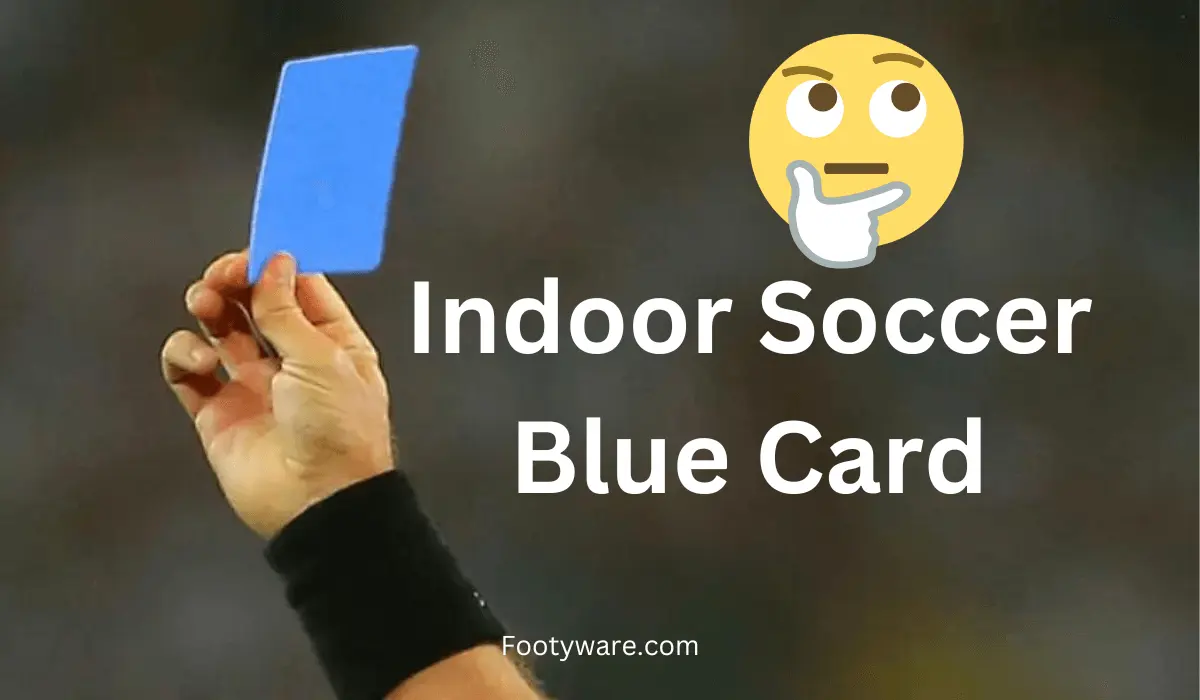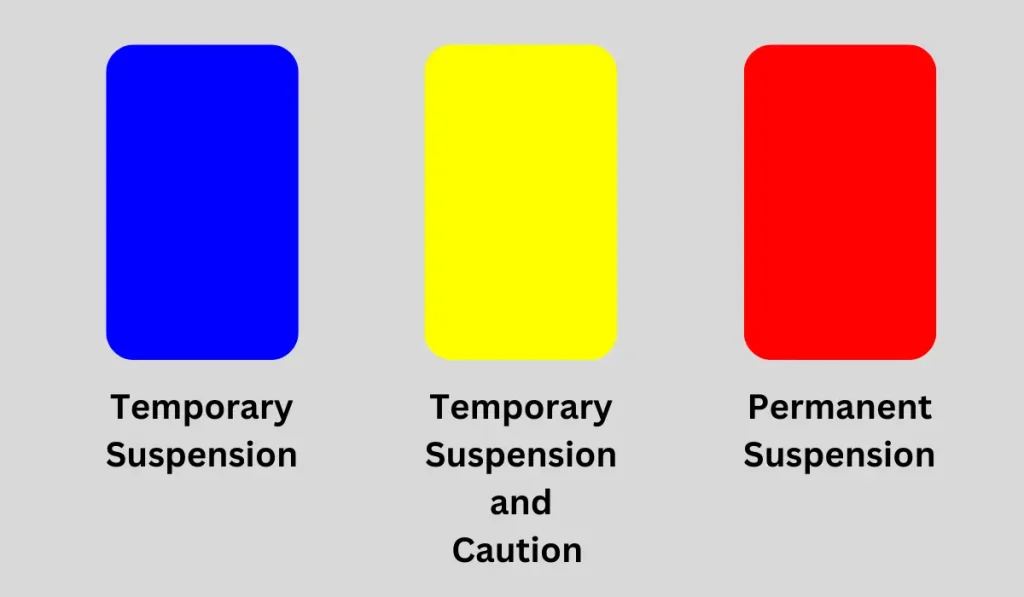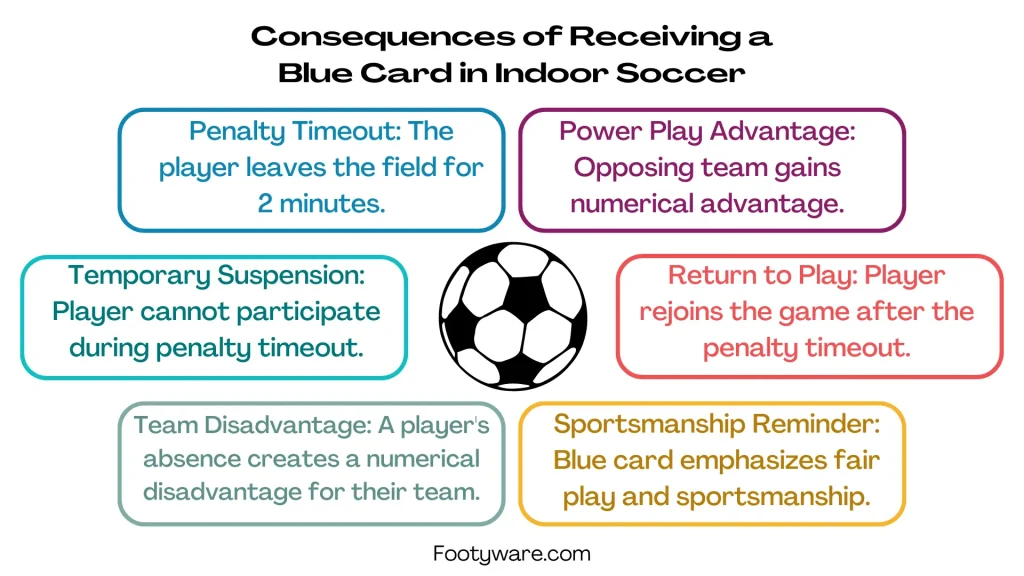Top Blue Card Indoor Soccer Rules

The referee’s whistle pierces the charged air of the indoor arena as players contest every ball with relentless intensity. Suddenly, a controversial tackle flares tempers. Reaching for a novel solution, the referee brandishes a Blue Card, immediately cooling tensions and restoring fair play.
This distinctive blue card has entered the indoor soccer scene aiming to transform the game’s culture. Beyond yellow and red consequences, the Blue Card allows referees to creatively defuse escalating confrontations before they boil over. But how does it work and will it catch on?
By explaining key concepts like penalties, fouls, cautions, and send-offs in indoor soccer, we’ll demystify when and how referees deploy the Blue Card. Discover how this experimental card influences tighter officiating and safer play indoors versus outdoor soccer.
While adoption varies across leagues, understanding the card’s origins and reception illuminates its impact. Drawing from indoor soccer’s governing bodies, referees, and years of first-hand experience, we’ll unpack everything around this controversial card.
Delve into the nuances of this disciplinary tool that has players, coaches, and fans debating. Is the Blue Card overkill or an ingenious way to curb unsportsmanlike behavior? Gain insights from all perspectives on this divisive innovation.
The Blue Card has entered indoor arenas aiming to reshape conduct. Learn what makes indoor soccer officiating uniquely challenging and how this card is reshuffling the deck to encourage fair, fun play.
Traditionally, soccer and its types like indoor soccer and futsal have been governed by a system of rules and regulations with the help of yellow cards and red cards. However, the introduction of the blue card adds a new dimension to the spectrum of penalties, focusing specifically on some minor gestures leading to serious offenses, while maintaining a fair balance between player safety and game flow.

| Section | Description |
|---|---|
| What is the Blue Card in Indoor Soccer? | An indoor Soccer blue card is being used for minor misconduct and offenses. It’s just a light warning. Unlike the red card in which you’re sent out of the field for the whole game in both indoor and outdoor soccer. |
| Offenses that Warrant a Blue Card | As a referee, I often encounter a range of offenses that can result in a blue card being issued in indoor soccer. These infractions include spitting on the indoor turf, persistent infringement, expressing dissent through words or actions, encroachment, illegal substitution, violations of house safety rules, and minor physical fouls. |
| Blue Card and Timed Penalties | Understanding the duration of penalty timeouts for blue cards, yellow cards, and red cards |
| Differentiating Blue Cards from Yellow and Red | Exploring the distinctions between blue, yellow, and red cards |
| Consequences of Receiving a Blue Card | Highlighting the impact of a blue card on the offending player and their team |
| Blue Cards in Indoor Soccer vs. Outdoor Soccer | Comparing the use of blue cards in indoor soccer to yellow and red cards in outdoor soccer |
| Conclusion: Understanding Indoor Soccer Blue Card | Summarizing the importance of comprehending and adhering to blue card rules |
Blue Card in Indoor Soccer
The blue card in indoor soccer rules is a minor penalty where an offending player sits in a penalty box area due to being temporarily suspended from match play, either for a duration of 2-minutes or until a goal is scored against the offending player’s team.
If you’re being shown a yellow card then you’re out of the game for at least 5 minutes or until the opponent scores against you. This is to discourage harsh fouls and misconduct while red cards make you walk out of the pitch for the whole game and your team will play with one man down.
Unlike the yellow and red cards, which are commonly used in outdoor soccer, the blue card is unique to indoor soccer. It serves as a distinct symbol of disciplinary action within this particular variant of the sport.
When Were Blue Cards Introduced into the Game?
Blue cards have been unofficially introduced into indoor soccer in various grassroots and youth initiatives as an alternative disciplinary measure to traditional yellow and red cards. While there is no specific date or widespread adoption at the professional level, the concept of blue cards has gained attention and experimentation in recent years.
Indoor soccer blue cards are relatively not that frequent in the game, primarily finding their application within the context of indoor soccer when addressing instances of minor misconduct while after being shown the blue card a second time you’ve to leave the pitch for 5-minutes or unless opponents score against your team and after 3rd blue it’s considered red card means you’ve left the pitch for the whole match.
Offenses that Warrant a Blue Card
In the context of indoor soccer, the referee utilizes a blue card to caution players for engaging in minor offenses, collectively termed “unsporting behaviors.” These unsporting behaviors encompass a range of transgressions that can disrupt the flow and fair play in the game. Some examples of offenses that can warrant a blue card include:
- Spitting on the indoor turf
- Persistent infringements
- Dissent through words or actions
- Encroachment
- Illegal substitutions or too many players on the field
- Violations of house safety rules
- Minor physical fouls
The issuance of a blue card serves as a warning and a means to maintain discipline on the field.
Are Blue Cards Restricted to Indoor Soccer Games?
Blue cards are primarily associated with indoor soccer games. They are commonly used as a disciplinary tool in indoor soccer to address minor charges. The use of blue cards is more prevalent and widely recognized in indoor soccer compared to outdoor soccer.
In outdoor soccer, the traditional yellow and red cards are the standard means of issuing cautions and dismissals to players. While blue cards are primarily restricted to indoor soccer, their implementation can vary depending on the specific rules and regulations of different indoor soccer leagues, tournaments, or regions.
This is the total discretion of the referee to decide about the offense and charge accordingly because if players start making rough tackles and challenges then the referee has to make them responsible for their actions according to the severity of the foul being conducted.
How is a Blue Card Different from Other Cards in Soccer?
Table: Differences Between Indoor Soccer Blue Card and Yellow/Red Cards in Outdoor Soccer
| Specifications | Blue Card (Indoor Soccer) | Yellow Card (Outdoor Soccer) | Red Card (Outdoor Soccer) |
|---|---|---|---|
| Offense Severity | Minor offenses | More severe offenses | Serious offenses or committing harsh fouls |
| Punishment Level | The player is ejected from the game | Intermediate level | Highest level of punishment |
| Penalty Timeout | 2-minute penalty timeout | 5-Minutes timeout | The numerical disadvantage for 5-mins |
| Team Disadvantage | The numerical disadvantage for the rest of the match | The numerical disadvantage for 2-mins | Power play advantage for the opposing team |
| Discretion of Referee | Determines blue or yellow | Determines yellow or red | Determines red card too |
| Impact on Gameplay | Timeout 2-mins or until the goal is scored against them | Power play advantage for the opposing team | Timeout 5-mins or until the goal is scored against them |
| Duration of Penalty | Timeout 2-mins or until goal is scored against them | The team plays with players less | Sent out of the field/court |
In indoor soccer, the blue card is reserved for minor offenses and results in a 2-minute penalty timeout, during which the offending team plays with a numerical disadvantage. The yellow card in outdoor soccer is for more severe offenses, while the red card signifies serious offenses or the accumulation of harsh fouls, leading him to go to the bench.
The referee has the discretion to determine whether an offense warrants a blue or yellow card in indoor soccer and a yellow or red card in outdoor soccer. The blue card creates a power play advantage for the opposing team, while the red card imposes a numerical disadvantage on the offending team for the rest of the match.
A blue card in soccer differs from other cards, such as yellow and red cards, in terms of its purpose and application. Here are the key distinctions:
Consequences of Receiving a Blue Card in Indoor Soccer

Receiving a blue card in indoor soccer entails specific consequences for the offending player and their team. When a player is issued a blue card, they are required to leave the playing area immediately for 2 minutes and sit in the penalty box. This designated area serves as the temporary suspension zone for penalized players.
During the player’s penalty timeout, their team plays with a numerical disadvantage, and the opposing team gains a power play advantage. Once the penalty timeout expires, the penalized player is invited back onto the field to resume participating in the game, but they must adhere to the rules and avoid any further offenses.
Here’s a quote from a reputable news outlet to this effect:
Source: Tampa Bay Times“The blue card is a third penalty card referees have been carrying this season in addition to the yellow and red. According to the FHSAA soccer manual, there is only one instance a blue card should be used: when a player uses his or her hands to prevent a goal-scoring opportunity. The offense was previously issued a red card, which resulted in the player being ejected and suspended for up to a week (two games). The team could not substitute for that player. With the blue card, the penalty is less severe. The player is disqualified from the game but is not subject to a suspension. The team is still not allowed to substitute.”
Conclusion of Indoor Soccer Blue Card
In closing, the blue card is an essential tool for referees to uphold fair play and safety in indoor soccer. Understanding what minor infractions warrant a blue card, like illegal substitutions, delay of game, and dissent, helps players respect the rules.
Unlike outdoor soccer, blue cards specifically signal a 2-minute penalty for the offending indoor player. This timeout allows teams to cool down and reset before tensions escalate further. While less severe than yellow and red card send-offs, blue cards still carry consequences for accumulated points.
Indoor soccer’s tight spaces and walls mean referees must vigilantly deter escalating physicality and misconduct through cards. Ensuring player security, promoting sportsmanship, and maintaining game flow is imperative. That’s why major indoor leagues worldwide utilize blue cards and penalties, despite some initial controversy.
Ultimately, players, coaches, fans, and officials all want exciting indoor soccer played fairly. Familiarizing yourself with blue card rules will only deepen your appreciation of the game. So next time you see that blue card raised, understand it’s for the good of the sport. Through awareness and respect, we can enjoy indoor soccer’s nonstop action while putting safety and integrity first.
